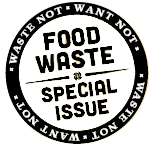Four-Legged Scrap Specialists
Feed leftovers to your critters, not the trash can
When I was growing up, if you wanted to buy store-bought food for your cat you had two choices: Meow Mix or 9Lives, and that was pretty fancy. Household cats scavenged for mice and got table scraps—and they didn’t have skin allergies or digestive problems. Same for dogs: They were a part of a family dynamic, gobbling up the food scraps that now make up the majority of the trash in our landfills. The rest of the scraps went to the backyard chickens and the hogs, if you had them.
So, I guess the big question for me is: How did we go from enjoying “leftovers” for dinner the following night and then feeding what remained to our household pets to simply tossing so much edible food into the trash? I will not disrespect my own time by tossing out something I participated in producing, so whatever we don’t eat I find another household mouth to feed it to. As a result our cats and dogs look lovingly my way at suppertime hoping some good “toppings” appear on their boring kibble.
pets to simply tossing so much edible food into the trash? I will not disrespect my own time by tossing out something I participated in producing, so whatever we don’t eat I find another household mouth to feed it to. As a result our cats and dogs look lovingly my way at suppertime hoping some good “toppings” appear on their boring kibble.
We are in the whole-animal business: We have our chickens processed whole; I know it is time to cook a chicken for supper when we have run out of “dog topping,” which is cooked skin and cartilage that is left after I have picked the carcass of meat. Our lambs are butchered to our specifications so it is easy for me to request organ meats and “bones bagged for the dogs.”
We have large-breed dogs that are well-suited to eating lamb bones; even our red heeler easily chews the smaller spare rib flaps. These uncooked soft bones that would have otherwise been picked up by a rendering company instead make a nutritious addition to our dogs’ diet. It also offsets some of our commercial dog food costs. These raw bones have bits of meat and connective tissue on them so they are frozen until ready to use. The bones themselves provide calcium and phosphorus, the marrow a bit of blood and fat, and the cartilage (which is mostly not digestible) contains glucosamine and chondroitin (I remember buying pills of glucosamine and chondroitin for our old Newfoundland, Bear, when he was having trouble with his old hips!)
These bones also help to keep the big dogs’ teeth clean. Fast-growing, large-breed puppies, like our Great Pyrenees and Maremma, especially benefitted from this natural delivery of calcium and phosphorus as they grew into their large frames.
Even a wonky egg plays a part in feeding our pets and working dogs. Eggs that have hairline cracks go into my refrigerator; those cracked with a broken membrane get cooked and put on the dogs’ food. Occasionally they get a raw egg but my vet warns that too many raw eggs can cause a biotin deficiency in dogs. The egg whites contain a biotin inhibitor but the yolk contains biotin so a few raw eggs a week and a few cooked prove to be a safe balance. We have had no evidence of indigestion or skin disorders so I feel like a few raw eggs work for us. Some even advocate grinding the eggshell and sprinkling it on the pet’s food but I usually just crunch them up and throw them to the hens for some shell-strengthening calcium. That’s what I call recycling.
Since most of us are not in the whole-animal business, here is another example: Everyone loves boneless, skinless chicken breast, right? Well, those bones and skin were on that breast at one point but someone had to remove them (you get charged for this in the price of the naked breast). Likely the bones and skin are rendered into the dog and cat food you buy for your pets, so why not purchase the bone-in, skin-on breast — which may actually taste a bit juicier and cost a bit less — and the dogs can have the cooked leftover skin on their food? In order to get the most out of this scenario, you could freeze your cooked bones until you accumulate enough leftover material to throw in a pot and make some chicken stock. Or debone the breast before you cook it and offer it the dog.
Or, better still: Purchase whole chickens! An uncooked neck (which is found in the cavity of whole chickens packaged for sale) is a great place to start for smaller dogs, and even cats. If you have ever watched a cat reduce a bunny to a pile of organs (sweetly left as a present to you by the back door) you will feel confident that your cat can handle a raw chicken neck. And the fact that the animal can sink its teeth into the neck helps to clean the teeth to the gum line for improved dental hygiene, among other things.
Veterinary medicine recognizes the benefit of meat, fruit and vegetables and other non-processed table scraps but I urge you not to feed your critter from the table, rather at routine pet meal times. We want happy pets, not moochy ones doped up on potato chips.





